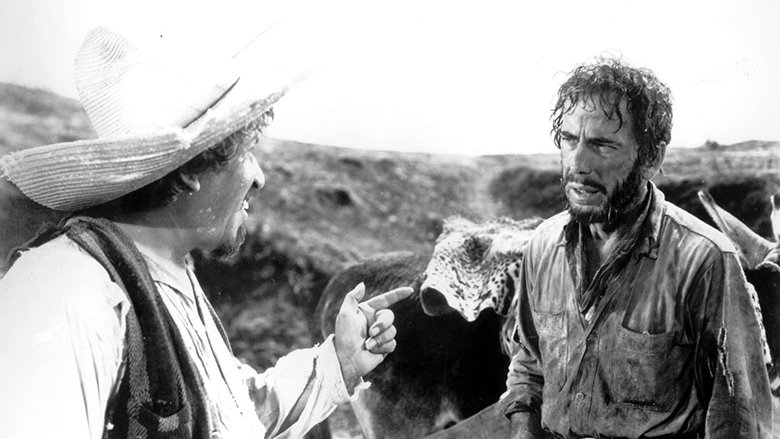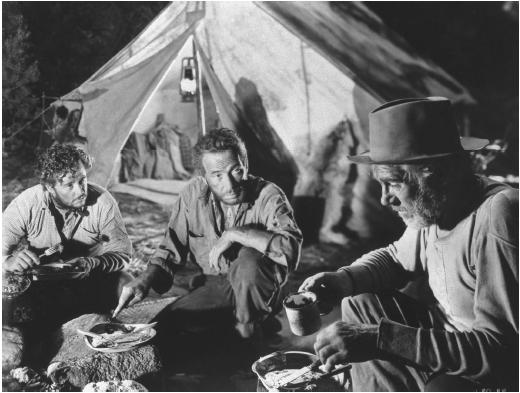← Back to Reviews

in
#587 - The Treasure of the Sierra Madre
John Huston, 1948

In 1920s Mexico, a trio of unemployed Americans head into the mountains in search of gold.
With his weather-beaten features and his rough yet nasal voice, Humphrey Bogart still makes for an unlikely example of a classic A-list movie star. Several of his most famous roles tend to bypass his gravelly countenance and sell him as a damaged anti-hero with a slightly romantic edge, for good (Casablanca) or not-so-good (Sabrina). The Treasure of the Sierra Madre might just be my favourite film to feature the man and it doesn't feature him playing one of his usual anti-heroic types or even a straight-up villain like in The Petrified Forest. Here, Bogart plays Fred C. Dobbs, an American who is down and out in a Mexican town in 1925. After trying to beg money off rich folks and getting cheated out of being paid for fair work, he and his equally impoverished buddy Bob Curtin (Tim Holt) decide to take up prospecting, hoping to find gold in the unexplored wilderness. To help them out on this venture, they bring in an older and more experienced prospector named Howard (Walter Huston), who agrees to guide them on their journey to riches. Of course, once the trio actually find a suitable vein of gold to mine, they must contend with various threats such as murderous bandits, opportunistic explorers, dangerous animals and, last but definitely not least, the greed and paranoia that affects all three of them (especially Dobbs).
The Treasure of the Sierra Madre is a pretty masterful example of classic cinema thanks to its tautly paced plot that doesn't drag over the course of two hours, generating as much drama from the growing friction between its three leads as it does from having their operation be endangered by external conflicts. Each of the three leads is definitely good enough to carry their own weight and prop one another up; as Dobbs, Bogart gives us a desperate man whose desire to simply make enough money to survive quickly escalates into an extremely obsessive mindset that puts him at odds with his companions, leading to a performance that drops his trademark sense of hard-boiled charisma in favour of an increasingly manic and deranged performance. His tendency to lapse into motor-mouthed diatribes is matched by the senior Huston, whose advanced age does not prevent him from being able to keep up with (and even surpass) Bogart in terms of being able to rattle off lines of dialogue like machine-gun fire. Though his old-prospector mannerisms are likely to prompt laughter in a few instances, they only make him an even more charming and layered character rather than render his dramatics ridiculous. Between these two, Holt's more restrained turn as an earnest young man simply looking to make a small fortune instead of a large one is an appropriately understated one; as a result, he doesn't need to go overboard with it. Outside of the core ensemble, other memorable performances include the smooth-talking explorer (Bruce Bennett) and the Mexican bandit leader (Alfonso Bedoya) who put in good turns that don't break the film's rhythms with their appearances.
Though I naturally need to revisit a few of the other contenders to make sure, I would probably still cite The Treasure of the Sierra Madre as my favourite Bogart film, my favourite Huston film, and basically a second-tier favourite. The film is paced incredibly well with each external development spread far enough apart so that the film can addresses each new twist without losing focus or an audience's interest. In addition to forming a satisfactory whole, the film is peppered with great individual moments, whether it's the famous exchange about stinking badges or a certain scene involving a gila monster. The focus on exploring the ramifications of greed does so by giving its leads great character development, with each one embodying a very different reaction to the promise of striking it rich. On a technical level, the film is extremely well-made with sharp black-and-white cinematography doing well at capturing the sun-soaked hillsides and being even better at covering the trio's nights spent by the fireside. The music is naturally old-timey yet the frequent repetitions and variations of the film's main theme never grow tiresome. All things considered, this is quite the old-school masterpiece and is definitely recommended.
John Huston, 1948

In 1920s Mexico, a trio of unemployed Americans head into the mountains in search of gold.
With his weather-beaten features and his rough yet nasal voice, Humphrey Bogart still makes for an unlikely example of a classic A-list movie star. Several of his most famous roles tend to bypass his gravelly countenance and sell him as a damaged anti-hero with a slightly romantic edge, for good (Casablanca) or not-so-good (Sabrina). The Treasure of the Sierra Madre might just be my favourite film to feature the man and it doesn't feature him playing one of his usual anti-heroic types or even a straight-up villain like in The Petrified Forest. Here, Bogart plays Fred C. Dobbs, an American who is down and out in a Mexican town in 1925. After trying to beg money off rich folks and getting cheated out of being paid for fair work, he and his equally impoverished buddy Bob Curtin (Tim Holt) decide to take up prospecting, hoping to find gold in the unexplored wilderness. To help them out on this venture, they bring in an older and more experienced prospector named Howard (Walter Huston), who agrees to guide them on their journey to riches. Of course, once the trio actually find a suitable vein of gold to mine, they must contend with various threats such as murderous bandits, opportunistic explorers, dangerous animals and, last but definitely not least, the greed and paranoia that affects all three of them (especially Dobbs).
The Treasure of the Sierra Madre is a pretty masterful example of classic cinema thanks to its tautly paced plot that doesn't drag over the course of two hours, generating as much drama from the growing friction between its three leads as it does from having their operation be endangered by external conflicts. Each of the three leads is definitely good enough to carry their own weight and prop one another up; as Dobbs, Bogart gives us a desperate man whose desire to simply make enough money to survive quickly escalates into an extremely obsessive mindset that puts him at odds with his companions, leading to a performance that drops his trademark sense of hard-boiled charisma in favour of an increasingly manic and deranged performance. His tendency to lapse into motor-mouthed diatribes is matched by the senior Huston, whose advanced age does not prevent him from being able to keep up with (and even surpass) Bogart in terms of being able to rattle off lines of dialogue like machine-gun fire. Though his old-prospector mannerisms are likely to prompt laughter in a few instances, they only make him an even more charming and layered character rather than render his dramatics ridiculous. Between these two, Holt's more restrained turn as an earnest young man simply looking to make a small fortune instead of a large one is an appropriately understated one; as a result, he doesn't need to go overboard with it. Outside of the core ensemble, other memorable performances include the smooth-talking explorer (Bruce Bennett) and the Mexican bandit leader (Alfonso Bedoya) who put in good turns that don't break the film's rhythms with their appearances.
Though I naturally need to revisit a few of the other contenders to make sure, I would probably still cite The Treasure of the Sierra Madre as my favourite Bogart film, my favourite Huston film, and basically a second-tier favourite. The film is paced incredibly well with each external development spread far enough apart so that the film can addresses each new twist without losing focus or an audience's interest. In addition to forming a satisfactory whole, the film is peppered with great individual moments, whether it's the famous exchange about stinking badges or a certain scene involving a gila monster. The focus on exploring the ramifications of greed does so by giving its leads great character development, with each one embodying a very different reaction to the promise of striking it rich. On a technical level, the film is extremely well-made with sharp black-and-white cinematography doing well at capturing the sun-soaked hillsides and being even better at covering the trio's nights spent by the fireside. The music is naturally old-timey yet the frequent repetitions and variations of the film's main theme never grow tiresome. All things considered, this is quite the old-school masterpiece and is definitely recommended.
